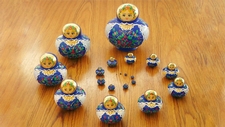Size

TEKS Objective
The student is expected to measure, compare, and contrast physical properties of matter, including size, mass, volume, states (solid, liquid, gas) temperature, magnetism, and the ability to sink or float.
Essential Understanding
The student knows that matter has physical properties and those properties determine how matter is classified, changed and used.
Science Background
What is Matter: MathMol (website) - Helpful explanation of the term “property,” as it relates to physical objects, and discussion of how we use properties to describe objects.
What is Matter
MathMol, www.nyu.edu/pages/mathmol
States of Matter: MathMol (website) - Discusses characteristic properties and behaviors of the three principle states of matter (solid, liquid and gas), including size and shape.
Signature Lesson
Investigating Size and Scale: Sciencelearn.org.nz (doc) - Students learn how the properties of matter can change with scale.
Investigating Size and Scale
Science Learning, Sciencelearn.org.nz
- Supporting Lessons
- Extensions
- Assessment Ideas
- Literature Connections
- Related
TEKS - Additional Resources
Supporting Lessons
Measuring Mass Tools: Ohio State University (PDF) – Students use metric measurements to compare objects.
Measuring Mass Tools
Ohio State University, www.gk-12.osu.edu
Tools of the Trade: Ohio State University (PDF) – Students select and use different tools to measure length, mass and volume.
Elaboration Lessons and Extensions
Matter, Matter, What's the Matter? Children’s Museum of Houston (PDF) - Four lesson-unit in which students explore the properties of matter, and classify objects according to physical properties, including size.
Matter, Matter, What’s the Matter?
Children's Museum of Houston, www.cmhouston.org
Assessment Ideas
Provide students with a variety of solid objects and have them measure each object’s dimensions. Also provide students with graduated cylinders with which to measure liquids.
Literature Connections
Sorting. Pluckrose, Henry (ISBN: 978-0516454580)
Matter. Wilkin, Fred (ISBN: 978-0516012841)
Matter: See It, Touch It, Taste It, Smell It. Stille, Darlene (978-1404803442)
Matter. Walker, Sally (ISBN: 978-0822528449)
Additional Resources
States of Matter Unit: Morton (IL) District 709 (PDF) - Two-three week unit on the properties of matter.
States of Matter Unit
Morton (IL) District 709, http://webs.morton709.org
TEKS Navigation
Grade 4
Need Assistance?
If you need help or have a question please use the links below to help resolve your problem.

Comments